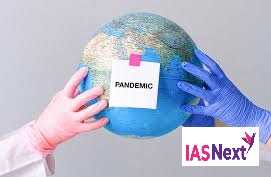CURRENT AFFAIRS
Get the most updated and recent current affair content on Padhaikaro.com
WHO’s pandemic treaty
- IAS NEXT, Lucknow
- 04, Mar 2022

Reference News:-
Members of the World Health Organisation (WHO) held the first round of negotiations towards the pandemic treaty on February 24, 2022.
- The meeting was aimed at agreeing on ways of working and timelines for a “convention, agreement or other international instrument” to prevent further pandemics and to improve the preparedness and response in case of its occurrence.
What is the pandemic treaty?
In December 2021, the Health Assembly adopted a decision titled “The World Together” at its second special session since it was founded in 1948.
- Under the decision, the health organisation established an intergovernmental negotiating body (INB) to draft and negotiate the contents of the pandemic treaty in compliance with Article 19 of the WHO Constitution.
- The pandemic treaty is expected to cover aspects like data sharing and genome sequencing of emerging viruses and equitable distribution of vaccines and drugs and related research throughout the world.
Need for:
- Solutions to the COVID-19 pandemic have seen an inequitable distribution of vaccines so far, with poorer countries at the mercy of others to receive preventive medication.
- Most countries have followed the “me-first” approach which is not an effective way to deal with a global pandemic.
Why is this treaty not a sufficient step to fight present or future pandemics?
- Treaty only provides recommendations for tackling a particular issue while ignoring that the countries especially in the south require resources and capacities to reach the public health targets.
- There is no focus on bridging these deficiencies or capacity inequities. That rich countries have given out far more booster shots in four months than poor countries have given out doses all year, reflects this capacity inequity b/w global North and the South.
- Any global effort must ensure distributed capacities so that countries and regions in the south have sovereignty over essential medicines, materials, manufacturing and supply chains.